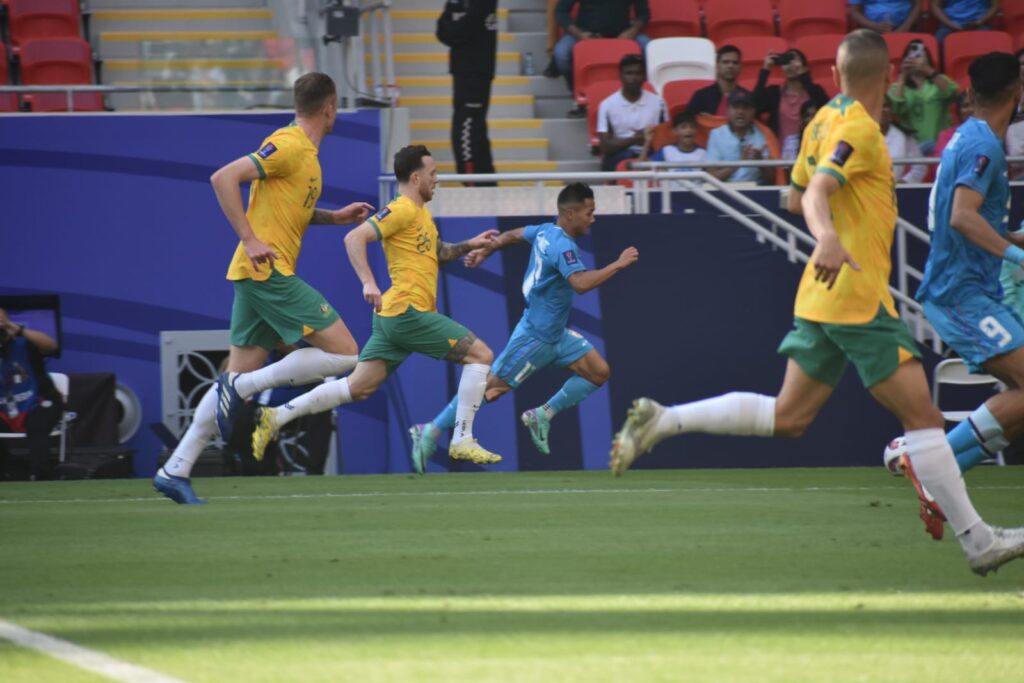
Rahul Giri in Doha
This isn’t a vintage Australian football team. There are no great players in the ranks, no one coveted by Europe’s biggest clubs. Though there will never be any shortage of effort and fight from those that wear green-and-gold, it’s hard to see this team going toe to toe with Japan or South Korea for the Asian Cup crown.
Yet, for all that, they were far too strong for India. A couple of Lallianzuala Chhangte runs and crosses from the left early on hinted at a proper contest, but it never materialised. As the game wore on, it was very much like watching a top-division team take on lower-league opposition in a Cup game. In fact, India’s passing accuracy, a fairly dismal 68 per cent, was pretty similar to what Huddersfield managed when thrashed 5-0 by Manchester City in the FA Cup a week ago.
What does that tell you? No good side misplaces one out of every three passes they attempt. And it wasn’t as though India’s players were trying to ping 40-yard balls like Xabi Alonso in his heyday. Even square balls to teammates five or ten yards away didn’t find their mark. The score line may have been respectable, but the 90 minutes were a sobering reminder of just how far behind India are.
There was some criticism of Igor Stimac, India’s coach, sitting on the bench and smiling before the final whistle. What was he supposed to do? Tear his hair out? With the exception of those out injured, this is the best of the talent he has to work with. That’s the grim reality.
Look at the teams in India’s group. Most of the Uzbek players are home-based, but a handful play for big clubs overseas. The absent Eldor Shomurodov, their attacking talisman, was good enough to play for AS Roma. Syria have players who learned the game in Argentina, while several of the Australians are scattered across Europe.
Riley McGree, who set up the second goal with a snaking run down the right, moved to Europe as a teenager, though it didn’t quite work out for him at Club Bruges, European Cup finalists in 1978. Jordan Bos, who scored that goal, is at Westerlo in Belgium, in the shop window for teams from bigger leagues to come calling.
When will an Indian player be in a similar situation? Sandesh Jhingan got no chances to play when he moved to Croatia, as was the case in the seasons that Gurpreet Singh Sandhu spent in Norway. And watching the Australia game, it wasn’t hard to see why there’s no demand for Indian players.
The defenders weren’t comfortable playing out from the back. Repeated hoofs up the field only found Matt Ryan or his defenders. The midfielders couldn’t shield the ball or find a teammate with a pass. And up front, no one could hold up the ball with his back to goal.
ALSO READ: 2023 Asian Cup: Gurpreet Error Opens Door for 2-0 Australian Victory over India
With very few exceptions, the Indian Super League (ISL) either gets young coaches looking to make a reputation or the dinosaurs who can no longer find a job in their home countries. Only a tiny handful, like Albert Roca at Bengaluru FC half a decade ago, worked at an elite level — he had assisted Frank Rijkaard in building Barcelona’s first great team of the 21st century.
But it’s also pointless pointing fingers at a Simon Grayson or John Gregory. Each time you watch Liverpool and marvel at Trent Alexander-Arnold’s passing ability, remember that he has been at their academy since the time he could walk in a straight line. Most of the Indian players hadn’t been part of an organised coaching set-up until they were in their teens.
This is a point that Stimac himself keeps emphasising. The accent at youth level has to be on developing skills, not results. Make players comfortable on the ball, so that they can play through the press instead of just kicking it away.
Long before Stimac’s days as a player, football in eastern Europe was renowned for the high level of technical skill. Back in 1981, in the Ballon d’Or voting, three of the top 11 were from tiny Georgia. In fact, Graeme Souness, who won three European Cups with Liverpool, once said that Dinamo Tbilisi, who thrashed the Reds 3-0 in 1979, were the best team he ever played against.
Regardless of whether Stimac, or someone else, is empowered to bring about root-and-branch change, that needs to happen. Japan’s 4-1 thrashing of Germany last September was no fluke. It was a result decades in the making, with the seeds sown even before the J.League was launched in 1993. Till such a framework is in place, especially at youth level, Indian football will have to be content with plucky defeats.
For latest sports news: click here




